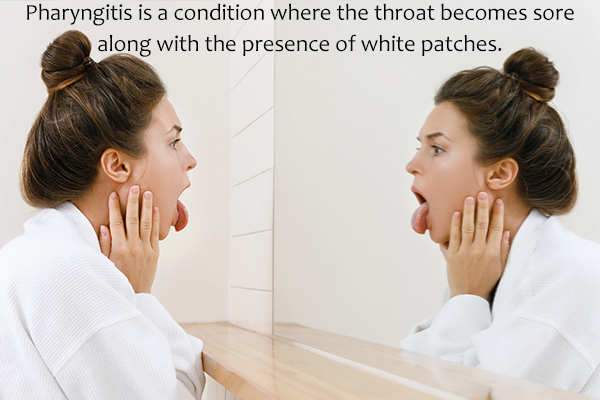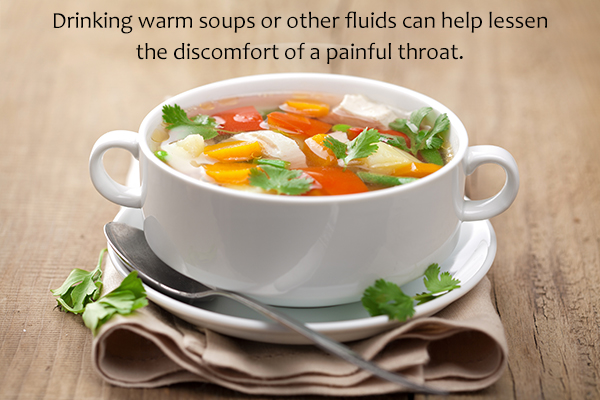In this article:
White spots at the back of the throat or on the tonsils can be a symptom of a variety of conditions, which may or may not be infectious.

In most cases, treating the underlying cause will make the patches go away. Thus, you must get yourself evaluated by a doctor to obtain a proper diagnosis, based on which the treatment will be prescribed.
Timely diagnosis and treatment are all the more necessary since these spots can be a sign of throat cancer.
Common Causes of White Spots at the Back of the Throat

White spots in the throat can be a result of any of the following conditions:
1. Strep throat
Strep throat is usually caused by a bacterial organism called Streptococcus haemolyticus. The bacteria can come from the tonsils, throat, or nose and can also cause tonsillitis. (1)
2. Pharyngitis
Pharyngitis is a condition where the throat becomes sore and white patches are present. Most cases are caused by viruses such as the ones that cause the flu or the common cold.
3. Mononucleosis
Mononucleosis, also known as mono or the kissing disease, is a contagious viral infection that is mostly caused by the Epstein-Barr virus (EBV), which spreads through the saliva.
This condition is typically marked by a sore throat and white patches in the throat. Other viruses can also cause this disease, but they can spread through other bodily fluids such as semen and blood in addition to saliva.
4. Syphilis
Syphilis is a sexually transmitted infection caused by a bacterium called Treponema pallidum, which can be picked up from an infected person’s open sore during sexual activity.
Early-stage syphilis presents with small sores called chancres in the genitals, rectum, or mouth. The tongue, uvula, and tonsil areas can also develop painless white ulcerations. (2)
5. Candidiasis
Candidiasis, or oral thrush, is a yeast infection that occurs in the mouth and throat and results in the appearance of white spots. Yeast is a fungus that can live on the skin and inside the body without causing any problem, but it can cause an infection if it multiplies excessively. (3)
6. Herpes esophagitis
Herpes esophagitis is a viral infection caused by the herpes simplex virus, which mostly affects people with compromised immunity. (4) This condition is characterized by a swollen and irritated food pipe along with the appearance of white lesions in the throat and on the tonsils. (4)
7. Tonsil stones
Tonsil stones, or tonsilloliths, are white, hard concentrations of bacteria and debris that get stuck in the crevices of the tonsils.
Dead cells and mucus bond together to form these stones. When this mix calcifies, it hardens and can become uncomfortable. They can cause bad breath or a sore throat but are not considered dangerous. (5)
8. Leukoplakia
Leukoplakia is a precancerous condition that causes thickened white patches on the gums, cheeks, and sometimes tongue that cannot be wiped or scraped off. The exact cause of this condition is unknown, but it has been related to tobacco use. (6)
9. Ingesting a caustic chemical substance
Ingesting a caustic chemical substance can burn the throat and result in the development of white spots in the affected area.
Different Treatments for White Spots in the Throat
The treatment for white spots in the throat depends upon the root cause. The most commonly used treatment interventions include the following:
- If it is determined that a bacterial infection is present, antibiotics will most likely be prescribed. This will hold true for strep throat.
- Tonsillitis is usually caused by a viral infection and the symptoms go away on their own. Occasionally, tonsillitis can be caused by bacteria, in which case antibiotics may be prescribed. However, if tonsillitis occurs chronically, removal of the tonsils, or a tonsillectomy, may be needed.
- Mononucleosis is caused by a virus and antibiotics are not prescribed for this. The most widely recommended remedy is to rest. Symptoms can be treated with over-the-counter analgesics and fever reducers. Staying hydrated is important.
- Once syphilis is diagnosed, the standard treatment is a long-acting penicillin antibiotic. (7)
- Candidiasis is caused by an overgrowth of yeast, a fungus. It is usually treated with azole antifungal agents. (8) Medication can come in liquid form that is swished in the mouth and then swallowed. It can also be tablets and lozenges. If the thrush is caused by poorly fitting dentures, use of antibiotics, or uncontrolled diabetes, these issues must be taken care of.
- Tonsil stones can be treated by gargling with a non-alcoholic mouthwash to loosen the stones and lower the amount of bacteria present. Removing the stones with a toothbrush by yourself could be dangerous and cause infection or aspiration of the stone. They usually dislodge on their own. If the tonsil stones are very large and uncomfortable, a tonsillectomy may be recommended.
- If white spots are the result of ingesting something that burned the throat, the cause of the burn should be removed. Emergency medical services (911) should be called, and medical attention will be needed.
- If the white spots are due to oral cancer, an oncologist will be needed to diagnose the extent and type of cancer present. Surgery, radiation, and chemotherapy are the treatment modalities that can be used.
Ways to Relieve Throat Discomfort Associated With These Lesions

Doctors usually recommend the following self-care measures along with medicinal or surgical therapy for white spots in the throat:
- After medical treatment, gargling with warm salt water may ease the symptoms. Lozenges can help ease the symptoms as well.
- Drinking warm soups or other fluids can help lessen the discomfort of a painful throat. Cold soft foods can also temporarily numb the throat and lessen the pain for a while.
- Throat lozenges may provide a cooling and numbing sensation.
- If you are able to gargle, a mixture of about a teaspoon of salt to a glass of warm water can be used to provide some comfort in the throat.
- Using a room humidifier in a dry room can help with throat discomfort.
- Over-the-counter pain relievers may be taken to help with the uncomfortable symptoms of a throat infection.
Diagnosis
The cause of white spots in the throat is identified by evaluating them in relation to the other coinciding symptoms. Diagnosis usually involves the following steps:
1. Medical history
The doctor will review your medical history, which involves an inquiry about:
- The symptoms that accompany the white spots, which can help narrow down the pool of culprits
- Any preexisting or previous health conditions
- Conditions that run in the family
- Other relevant factors, such as whether the white spots can be wiped off and any history of sexual activity with an infected partner
2. Physical exam
The doctor will conduct a physical analysis that typically involves:
- Close examination of the white spots
- Checking your ears and nose
- Evaluating your blood pressure
- Listening to your heart and lungs
- Feeling the lymph glands under your jaw and in your neck
3. Tests
The doctor may order a few blood tests. A throat culture may also be ordered, in which a cotton swab is quickly rubbed in your throat to get a sample.
This sample is then microscopically tested in the lab to identify the presence of any infectious organisms. This test determines if the cause is viral or bacterial.
Potential Complications

White spots in the throat can develop due to a wide range of conditions, each of which can give rise to specific complications in the absence of proper treatment.
- White spots can lead to swelling in the throat and, in extreme cases, impair the airway and interfere with breathing.
- Strep throat can lead to scarlet fever, kidney disease, rheumatic fever, and arthritis if not treated. A cough can accompany white spots in the throat, along with dry throat, difficulty swallowing, and breathing.
- Toxic chemical exposure from ingesting a caustic substance can burn the throat and gastrointestinal tract.
- Untreated syphilis can spread to the other organs, including the brain.
- Advanced oral cancer can result in death.
- A long-term yeast infection can lower the immune system, and the infection can spread to other parts of the body.
- Other complications include fever, chills, body aches, and enlarged lymph nodes, depending on the underlying cause of the white spots.
When to See a Doctor
A doctor should be seen immediately if you experience impaired breathing, signs of the skin turning blue, and ingestion of caustic chemicals. If the spots do not go away on their own after a few days, it is a good idea to see the doctor.
Final Word
White spots in the throat are not always serious. They often go away on their own. Keep your mouth clean and wash your hands to reduce bacterial and viral particles from entering the mouth. When in doubt, see your doctor.
- Was this article helpful?
- YES, THANKS!NOT REALLY


